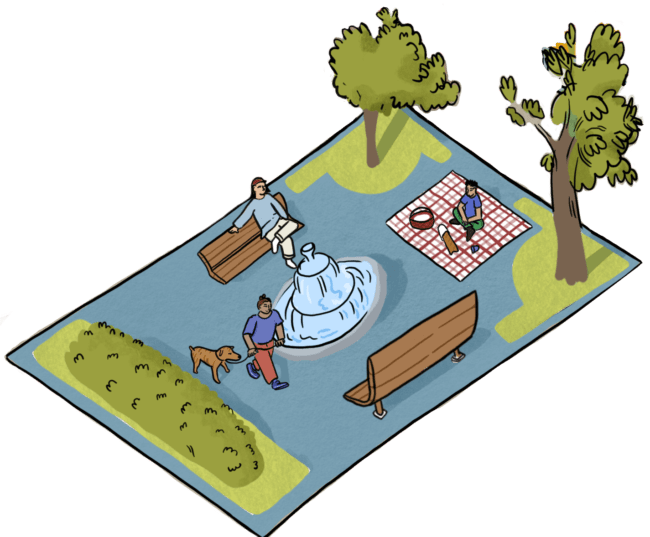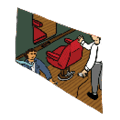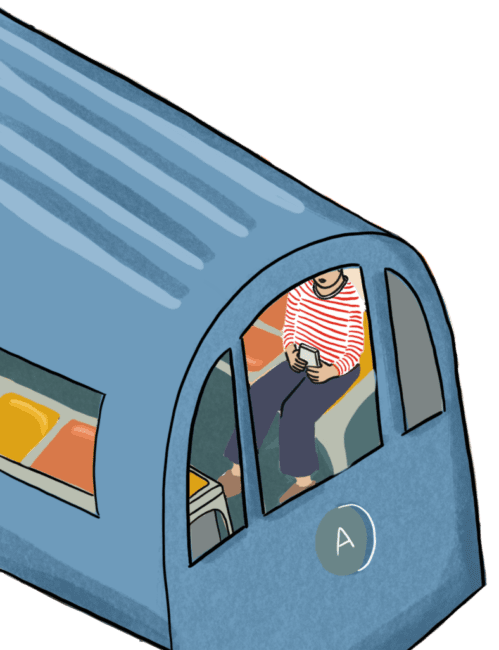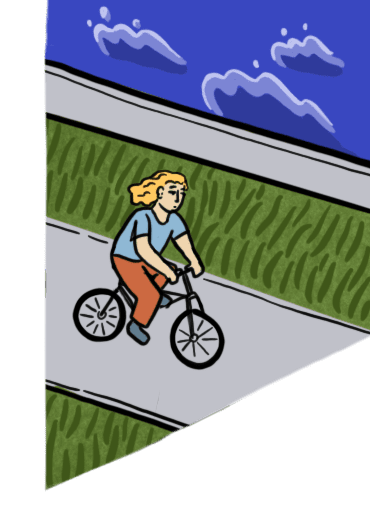How would the American Jobs Plan reshape neighborhoods?
As lawmakers in Washington debate the largest spending bills in generations, we’re thinking about how this long-sought influx of federal funding can lead to more just and resilient cities and neighborhoods. Where is the opportunity greatest? What resources are needed in addition to spending? What considerations need to be at the fore so that we’re not just spending trillions of dollars but also driving systemic change? Nineteen HR&A subject matter experts share their thoughts. Tell us yours on Twitter or LinkedIn and sign up for our newsletter here!
Click through to see some of what’s on the agenda.

Image by Santo Jacobsson. He has a BFA in illustration from The Parsons School of Design. He is an illustrator based in NYC and Minneapolis. His main work pulls from his Ecuadorian heritage and queer identity. Find more at https://santojacobsson.myportfolio.com/ and his instagram: @santojacobsson.
Climate Justice
Written by: Jose Serrano-McClain and Candace Damon
Decarbonizing our energy infrastructure represents one of the most important ways to make progress on slowing climate change. In the words of one friend, “We need to stop burning things.” With that shift comes the need to decommission thousands of fossil fuel power plants across the U.S. — potentially transforming the physical fabric of the communities in which they are located.
These are communities that share the distinction of suffering the compounding harms of environmental racism and economic marginalization. They can embody the framework for a just transition, to “stop the bad” and “build the new.”
What these frontline communities need are resources and tools to shape the energy transition.
The current version of the American Jobs Plan may provide the resources: it includes $100 billion for power infrastructure and economic development investments in distressed and disadvantaged coal, oil and gas, and power plant communities. This sum is allocated to a variety of initiatives, some of which may be available for communities seeking to transform power plant sites while creating good jobs for community members.
But leaders from the frontline communities also need tools: they should be provided with capacity-building and demonstration programs that will allow them to collaborate on the research and development of next-generation energy services, technologies, and business models. In New York State, pursuant to the State’s Climate Leadership and Community Protection Act, the New York State Energy Research and Development Authority is experimenting with developing these tools. Lessons can also be learned from the Justice40 Accelerator, which is supporting frontline communities to apply for federal funds to build community-led climate and environmental justice projects.
In these “community energy labs,” the reimagining of decommissioned plants can happen alongside the envisioning of new energy occupations, the launch of community-owned energy projects, and the testing of community-driven pilots that advance a shift toward clean energy, local agriculture, expansion of community health infrastructure, and resilience investments.
Back to list
Digital Inclusion
Written by: Danny Fuchs and David Gilford
Universal high-speed internet connectivity is the electrification of the 21st century, yet tens of millions of American families lack this essential utility. The American Jobs Plan proposes investing $100 billion in broadband infrastructure, a once-in-a-generation opportunity to close the digital divide. While this national support is critical, there is no one-size-fits-all solution. Our Broadband Equity Partnership survey of local leaders found that communities across the political spectrum want to be empowered to deliver fiber deployment, subscription subsidies, and digital inclusion programs with local perspectives and fresh ideas. Local voices must be at the forefront of implementation across sectors, including new community-led models of public-private partnership.
Back to list
Downtown Investment
Written by: Kate Collignon
Dynamic Central Business Districts were essential to the resurgence of cities in recent decades, sustaining and attracting a skilled workforce and fueling innovation and economic prosperity. But this success was not shared equally: to many people, “talent attraction” now invokes the specter of racial displacement. As CBDs struggle to recover and adapt from both the COVID shutdown and the longer-term impacts of remote work, we have an opportunity to leverage infrastructure funds through the American Jobs Act to produce both a more equitable recovery and more resilient CBDs:
- Leverage more than $200 billion in additional housing funds to convert office space that faces less demand amid remote work into affordable housing – sustaining and expanding activity downtown, diversifying uses to increase resilience amid future economic downturns, and ensuring broader participation in downtowns’ future.
- Tap into CDBGs and neighborhood resilience funding to invest in the public realm to sustain and increase access to open space of all kinds to rebuild and expand access to this heavily used lifeblood during the pandemic, particularly in locations with limited access to green space.
- Invest in adaptation of under-utilized storefronts to creative uses, and in the small businesses that have struggled amid the pandemic, recognizing the disproportionate impact that COVID has had on minority-owned businesses and leveraging more than $30 billion set aside for enhanced small business funding and MWBE investment.
- And – with more than $600 billion proposed for transportation infrastructure – sustain and enhance the road and rail networks that make it possible for CBDs and employees from throughout the region to thrive by connecting people with jobs.
For CBDs to deploy these funds directly, cities of all sizes will need to have access to a sufficient share of federal resources flowing through states and counties and be given appropriate discretion over their expenditures.
Back to list
Food Equity
Written by: Derek Fleming and David DeVaughn
The Biden administration’s broad, inclusive approach to infrastructure investment presents a much-needed opportunity to address the food systems inequity experienced by marginalized, under-resourced, and Black and Brown communities across the country. While COVID-19 has demonstrated how emergency food systems provide vital nutrition for communities in crisis, it has also highlighted the need for alternative, community-controlled models.
Local decisionmakers around the country have been seeking to make capital accessible for Black and Brown food entrepreneurs, to incentivize new types of equity-based food businesses, and to develop cooperative groceries and food hubs, among other innovations.
Billions of dollars of spending contained in the American Jobs Plan – from Community Development Block Grants to workforce and small business funding to climate and resiliency funding – could be used to invest in critical food system infrastructure that champions marginalized communities. If approached as an overlapping pool of resources, the billions of dollars allocated to neighborhood investment can avail an innovative re-alignment in food systems, supporting Black and Brown food entrepreneurs and their local economies through community asset building. These funds can be a down payment for hyper-local-to-regional projects that can sustain communities’ health and wellbeing, while being intentionally designed to address generations of disinvestment and extraction.
Back to list
Green Jobs
Written by: Judith Taylor and Garrett Rapsilber
The American Jobs Plan’s proposed $400 billion investment in clean energy, zero-emissions transportation, and climate resilience would remake the U.S. economy with the potential to upend longstanding inequities in access to high-road jobs.
However, the transition to a green economy will require new skills training and a purposeful effort to create a more equitable economy. While the Plan includes $100 billion to fund “proven workforce development approaches” targeted at underserved groups (including $48 billion for new apprenticeship and education programs and $12 billion to target workers facing some of the greatest barriers to employment, such as formerly incarcerated individuals), the effectiveness of these workforce investments rests on coordination among existing workforce development partners and on centering new approaches to engage historically underserved communities.
As described in our report for the Los Angeles Cleantech Incubator, many people do not understand the full extent of jobs or training within the green economy. In order for Plan dollars to be invested in the right training approaches that will create successful, equitable outcomes, more work needs to be done across the country to understand the region-specific distribution of green jobs. Further, an understanding of regional green jobs data can be leveraged by workforce programs to illustrate career opportunities for women and people of color and to proactively reach out to underrepresented communities through partnerships with local schools, institutions, and non-profits.
Our study found that technical training, such as electric vehicle maintenance or energy modeling, must be paired with soft skills training and braided services, such as childcare and transportation assistance, to increase participation of women and people of color in training programs. Finally, outreach and training must also target blue-collar workers in transitioning industries to ensure no one is left behind.
Back to list
Innovation
Written by: Bob Geolas and Mason Ailstock
Could there be a more exciting time for innovation? Communities across the country are developing innovation communities, hubs, districts, and centers. Research in areas from health, wellness, climate, food, as well as the usual tech sectors are booming. The proposed infrastructure investments offered by the President will provide essential fuel to ensure that such efforts generate the greatest economic benefit for the most people, from $45 billion for increased R&D capacity at Historically Black Colleges and Universities and other Minority-Serving Institutions, to $20 billion for regional innovation hubs that seek to spread the economic benefits of the knowledge economy beyond major metros, to $31 billion to fund small manufacturers and set up innovation hubs in communities of color and other underrepresented communities. Across these investments, urban and suburban collaboration, equitable economic outcomes, and convergent sectors are required to support broader societal goals and human benefit. Now is the time for innovation leaders and communities do a deep dive, evaluate innovation assets, prepare to pivot into a new 10-year strategic plan, and secure infrastructure investments that align with local goals to propel their communities forward… as we all Build Back Better.
Back to list
Parks
Written by: Connie Chung
Parks are infrastructure – yet they’re not specifically included in the American Jobs Plan. Instead, there’s $50B to support resilient infrastructure (through FEMA’s Building Resilient Infrastructure and Communities program, HUD’s Community Development Block Grant program, new initiatives at the Department of Transportation, and others). Park system operators and advocates should seize the opportunity to tap into these funding sources, which can support hazard mitigation, nature-based solutions, capacity building, public-private partnerships, and a breadth of other public benefits. It’s obvious to us that parks fit the bill – they are nature-based solutions to mitigate climate change; they provide much-needed refuge; they are critical to public health; they create and sustain good jobs; they can protect us from flooding; and they bring joy. But tapping into this funding will require deliberate partnerships, credible demonstration of projects’ value (defined broadly), and a courageous rethinking of what we mean by “infrastructure” to include your riverfront, your running trail, and your neighborhood park.
Back to list
Retail
Written by: Kate Coburn and Sulin Carling
Storefronts are social and economic infrastructure of cities and neighborhoods, providing goods and services, entrepreneurship opportunities, and vibrancy. COVID-19 has caused a proliferation of vacant storefronts. We must leverage the American Jobs Plan’s small business support and transportation infrastructure funds to support storefront businesses and promote experience-focused storefront uses that can thrive in the era of e-commerce. We should:
- Enhance experiences from storefront to sidewalk. Municipalities should widen sidewalks and help businesses create permanent outdoor seating structures while making open streets permanent.
- Fund pop-up retail incubators in vacant storefronts. BIDs or other community organizations can lease underutilized storefronts and provide free space to entrepreneurs testing concepts before moving into permanent space.
- Invest in digital infrastructure to help small businesses remain competitive. Local governments and BIDs should invest in broadband and shared online shopping platforms encouraging “shopping local,” replicating ShopInNYC, which offers free same-day shipping within NYC for orders over $59 from local businesses.
- Facilitate innovative storefront reuse. Cities can fund technical assistance and ease zoning to encourage new uses such as pop-ups, co-located microbusinesses, or even housing.
These investments in commercial corridors will provide returns on par with the bridges and highways that get people there.
Back to list
Rethinking Urban Highways
Written by: Olivia Moss
Described by Secretary Buttigieg as “…a legacy of misguided investments and missed opportunities in federal transportation policies that reinforce racial and economic inequality,” highways have left scars in neighborhoods throughout the country, disrupting residents’ economic and housing stability and uprooting local businesses. The $20 billion commitment in the American Jobs Plan for programs to reconnect these neighborhoods with a focus on equity can support local government and advocates’ efforts to create covers or lids over highways, fill sunken expressways, and transform elevated highways into boulevards.
These projects in turn can create new space for parks, housing, and other community-serving uses. Such projects require thoughtful planning to develop strategies for funding complex infrastructure, enabling equitable development, and establishing governance structures to steward progress toward community goals. Even with federal funding, these projects represent major investments for local governments – a clear analysis of the benefits that align with such investment can guide decision-making and demonstrate the economic and equity benefits that can be accomplished by reconnecting neighborhoods and replacing relics of a misguided urban policy with new community assets.
Back to list
Tech for Good
Written by: Kate Wittels
With the onset of the pandemic we learned that high-speed internet is not a luxury but a necessary utility that all Americans need to participate economically, civically, and socially. But access to broadband is only half the battle – people also need internet-enabled devices to access the many useful websites and platforms that can make our lives more productive, as well as training on how to navigate the sites and software products.
As we saw with K-12 education during the last year, there are many great ed tech tools, but education cannot magically transition unless the teachers, parents, and students have devices and are taught how to use the tools. The American Families Plan calls for investing $9 billion in teacher training – we hope that part of the $9 billion will be spent on tech skills development and software awareness so teachers can leverage the best that ed tech can offer. More also needs to be done to ensure that all teachers and students have functioning tablets and computers. While the days of 100% remote education may be behind us, many of the software products that we depended on will likely remain and be integrated into teaching methodologies for years to come.
Back to list
Transit
Written by: Amitabh Barthakur and Paul Silvern
Transit can play an essential role in economic recovery and future resiliency of our cities and regions. Transit’s function – connecting people to jobs and services – and its well-documented impacts on expanding access to quality jobs, reducing congestion, and enabling sustainable growth ensure that increased investment in transit service and infrastructure will be a critical component of equitable economic expansion in our cities.
This is indeed a time to double down on these investments, and we are very happy to see some of the initiatives identified in the American Jobs Plan, including $85 billion to modernize existing transit and expand rail and bus transit systems and an $80 billion investment in Amtrak and national freight service. Transit agencies should work in close coordination with state and local governments while deploying these resources to ensure that they can leverage additional private investment and additional dollars identified in the American Jobs Plan (such as $20 billion to reconnect neighborhoods cut off by highways and $5 billion to redevelop contaminated brownfield sites) to support equitable growth.
Back to list
Urban Resilience
Written by: Jonathan Meyers
In most cities in America, property taxes represent a large portion of local government revenues, and these revenues are often the cornerstone of local governments’ ability to fund operations and pay debt service. Local governments face a major threat to their underlying business model in the form of climate risk. In most cases, assessed property value does not fully reflect climate risk. Among the many concerns associated with weather and human activity, these risks will significantly erode property value (and therefore local revenue). This may happen slowly, through actual loss of land to subsidence and costs of nuisance flooding, or it may happen in a single catastrophic event. In either case, local governments will be left without resources, and without the revenue needed to fund future investments.
The American Jobs Plan reflects the desire to invest in resilient and sustainable infrastructure at a local level, allocating $50 billion to safeguard critical infrastructure and protect communities from climate risks. This funding provides an opportunity to make thoughtful and necessary investments now – investments that address historic inequalities in where people live, in terms of how services are allocated and how infrastructure has been designed and built. This will also require us to think long-term about how City services are financed, how budgetary risks related to climate change can be mitigated, and how the restructuring of a City’s “business model” must be an opportunity for a more equitable and inclusive approach.
Back to list

















